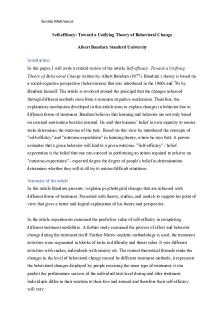Individual Assignment 4 PDF

| Title | Individual Assignment 4 |
|---|---|
| Author | Joy Harker |
| Course | Strategic Planning/Business Policy |
| Institution | Liberty University |
| Pages | 7 |
| File Size | 135.1 KB |
| File Type | |
| Total Downloads | 71 |
| Total Views | 143 |
Summary
Alphabet Industries Assignment ...
Description
Alphabet, Inc. Strategic Plan J***** W***** Liberty University BUSI 400 – B07 6.26.2019
2 ALPHABET STRATEGIC PLAN
Vision Alphabet, Inc. was born of a vision to create a “collection of companies” (Alphabet, 2019). The goal in creating this collection, the largest of these being Google, is to run independently these businesses that are, to a large degree unrelated, in way that would not be possible with a traditional company structure. Opportunities and innovation are at the heart of Alphabet, carrying an emphasis on stretching existing boundaries. Mission The mission of Alphabet is to foster the individuality of each business that they currently own. Alphabet and Google both share the same mission of “Organizing the world’s information and making it universally acceptable and useful.” (Alphabet, 2019). Values Google’s founders Larry Page and Sergey Brin very much serve as driving forces in Alphabet’s value system. It is said that great leaders are characterized by the value that they bring to a company and the values that they instill in others within the company; both Page and Brin are known for the value and spirit of innovation that they brought and bring to Google. These two leaders remained in their positions until the time of Alphabet’s birth, after which they became CEO and president of Alphabet, with Sundar Pichai taking the role of Google’s CEO. The company as a whole values innovation and collaboration, always seeking to improve their current position and offerings.
SWOT Analysis Strengths: 1. Alphabet, specifically Google, dominates the world of web searches, online advertising, browser usage and the sharing of video content. Google’s primary areas of competition are web searches and online advertising. According to one source “Google AdWords accounts for 68% of the company’s revenue in 2015. Google’s aggregate paid clicks, a key advertising measure, rose 31% from the previous year, beating the consensus
3 ALPHABET STRATEGIC PLAN
expectation of a 22% rise.” (Davila, 2016). The following chart shows that Google and Facebook account for upward of 60% of global online advertising revenues.
Web Searches, as stated above, are one of Google’s strengths at this time. According to Net Market Share “The global marketing share percentage, in terms of the use of Search Engines heavily favored Google throughout 2017 - averaging a net share of 74.54%.” (Mangles, 2018). Google’s services together provide them with an enormous amount of information regarding users, providing quite a competitive advantage. Google is able to target specific audiences according to their understood preferences and needs. 2. The second of Google’s key strengths lies in acquisitions. Between 2001 and 2019, Alphabet acquired 214 companies, 56 of these within the last 5 years. (N.A., 2019). Alphabet has chosen this avenue to gain a greater competitive advantage. Through these acquisitions, they are able to gain new skills, technologies and improve on their own services and products. Weaknesses: A. As shown above, advertising represents a great percentage of Alphabet’s revenues. Google’s largest strength may also become its greatest weakness in that the company is relying heavily on one source of revenue. Many of these services operate outside of contracts meaning that the longevity of these revenue sources is in no way guaranteed. B. Alphabet’s portfolio encompasses a number of businesses offering a vast number of products and services. Many of these new initiatives require large amounts of capital
4 ALPHABET STRATEGIC PLAN
for research and development to continue. With this system comes the risk of failure and lack of profits in the future. Opportunities: 1. Alphabet’s recent acquisitions award them a number of new opportunities to reach new markets and to diversify their portfolio. Control over these newer businesses and initiatives, in many ways, allows them a greater degree of cohesiveness among their services. As stated above, Alphabet may use their knowledge of consumers/ clients to better serve and target current and future users. 2. Cloud services are another area in which Alphabet has a number of opportunities. In recent years, there has been a shift toward usage of cloud computing, leading to greater opportunities for development in this area. 3. Finally, the shift from desktop/ laptop work to mobile devices provides Alphabet with a great opportunity to further the publics’ reliance on their services. If they can target the needs of current users and create user friendly technology to meet these needs, they will further increase their market share in coming years. Threats: 1. As mentioned above, Google’s growth rate has historically been a steep one. Maintaining this level of growth in coming years will prove to be difficult. However, if Alphabet chooses to capitalize on the opportunities mentioned above and continue in innovative efforts, they may indeed be able to continue Google’s current growth trend. 2. A second threat is that of new competitors. Although Google does have a number of competitors, they continue to update their services in order to compete with other businesses. One source reports that “Google has been steadily updating its tools for businesses looking to reach more customers across Google’s platforms, including Search and Google Maps. Last year the company took on Facebook pages with a feature that lets users ‘follow’ and message businesses directly, as well as be updated about promotions, sales and other events. Today, Google is rolling out a host of other tools for Google My Business, focused on attracting customers and encouraging follows.” (Perez, 2019).
5 ALPHABET STRATEGIC PLAN
Porter’s Five Forces Analysis Innovation is the main source of concern regarding new competitors of Alphabet. If these new entrants can lower costs and compete with Alphabet through lower pricing strategies while maintaining an innovative edge, they may become a serious threat to the company. Alphabet can address any threats of new entrants by continuing in their innovation efforts, and by building economies of scale, enabling them to lower their per unit fixed costs. The Bargaining Power of Buyers could be one of Alphabet’s key concerns, in that they could put pressure on Alphabet’s long-term profitability. Alphabet may overcome this by expanding their customer base to the point that the bargaining power of buyers is reduced. This also enables Alphabet to streamline its products and services. Another way that Alphabet may defeat this issue is through innovation, and demand creation. Dedicated and trustworthy suppliers are one of the keys to Alphabet’s success. They will be able to tackle the Bargaining Power of Suppliers through developing these suppliers, building effective and efficient supply chains, and by considering alternative products in case of the event in which a supplier is no longer available or suitable to the company’s needs. The threat of substitute products or services is a threat to Alphabet’s long-term success. The industry that Alphabet serves is fast paced and ever-changing. As stated above, innovation is the key to their success. This is especially true of Google’s success. If they are unable to remain innovative in their industry, they will be unable to remain profitable. Ways that they may differentiate themselves from other services could include customer services, an understanding of customer needs and desires, or even increased switching costs for customers. The industry of internet information providers is an extremely competitive one. Industry rivalry is possibly Alphabet’s biggest concern. As addressed above, innovation and differentiation are the key to Alphabet’s long-term success. One possibility to consider is collaboration with competitors in an attempt to increase market share and market size. Recommendations
6 ALPHABET STRATEGIC PLAN
As discussed above, Alphabet’s current competitive advantages lie in their diversification of products and services, website searches, and digital and online advertising. To continue to improve in these areas, while further developing their cloud services, will allow them a greater opportunity to expand their target market while meeting the needs and desires of current and future users. Alphabet is unique in their position as a leader in so many areas and services. Google’s digital or web-based services may work in conjunction with one another to provide Alphabet with an accurate picture of consumer trends, desires and needs. Alphabet will do well to use this knowledge to capitalize on opportunities for expansion and growth. Alphabet does appear to be attempting to build an ambidextrous firm. If in no area other than innovation, this is clearly seen through the company’s use of incremental and radical innovation. During an interview, Jonathan Rosenberg, advisor to Alphabet’s management, was quoted as saying “The best definition of a major innovation is one that establishes a new framework for working out incremental innovation, which means, new industries.” (Rosenberg, 2018). Google specifically employs both approaches. They are heavily focused on radical innovation while still employing incremental innovations to refine or sustain current and past innovations.
7 ALPHABET STRATEGIC PLAN
References: Davila, D. (2016). Google’s 6 Most Profitable Lines of Business. Retrieved from https://www.investopedia.com/articles/markets/030416/googles-6-mostprofitable-lines-business-googl.asp Image: Retrieved from https://www.statista.com/chart/12179/google-and-facebook-shareof-ad-revenue/ Mangles, C (2018). Search Engine Statistics. Retrieved from https://www.smartinsights.com/search-engine-marketing/search-engine-statistics/ Perez, S. (2019). Google Ramps up Competition with Facebook Pages with New Tools for Local Businesses. TechCrunch. Retrieved from https://techcrunch.com/2019/06/20/google-ramps-up-competition-with-facebookpages-with-new-tools-for-local-businesses/ Roseberg, J. (2018). With Jonathan Rosenberg, Advisor to Alphabet Management:How to Start Radical Innovation. Forbes. Retrieved from https://www.forbes.com/sites/sunniegiles/2018/03/25/with-jonathan-rosenbergadvisor-to-alphabet-management-how-to-start-radical-innovation/#28c520aca204...
Similar Free PDFs

Ch.4 Individual Assignment
- 5 Pages

Individual Assignment 4
- 7 Pages

Individual Assignment
- 26 Pages

Individual Assignment
- 20 Pages

Individual assignment
- 5 Pages

Individual assignment
- 3 Pages

MGT 162 INDIVIDUAL ASSIGNMENT
- 24 Pages

finance - individual assignment
- 7 Pages

Mkt individual assignment
- 4 Pages

BUS assignment individual
- 7 Pages

Report - Assignment 2 : Individual
- 11 Pages

Individual Assignment 1
- 1 Pages
Popular Institutions
- Tinajero National High School - Annex
- Politeknik Caltex Riau
- Yokohama City University
- SGT University
- University of Al-Qadisiyah
- Divine Word College of Vigan
- Techniek College Rotterdam
- Universidade de Santiago
- Universiti Teknologi MARA Cawangan Johor Kampus Pasir Gudang
- Poltekkes Kemenkes Yogyakarta
- Baguio City National High School
- Colegio san marcos
- preparatoria uno
- Centro de Bachillerato Tecnológico Industrial y de Servicios No. 107
- Dalian Maritime University
- Quang Trung Secondary School
- Colegio Tecnológico en Informática
- Corporación Regional de Educación Superior
- Grupo CEDVA
- Dar Al Uloom University
- Centro de Estudios Preuniversitarios de la Universidad Nacional de Ingeniería
- 上智大学
- Aakash International School, Nuna Majara
- San Felipe Neri Catholic School
- Kang Chiao International School - New Taipei City
- Misamis Occidental National High School
- Institución Educativa Escuela Normal Juan Ladrilleros
- Kolehiyo ng Pantukan
- Batanes State College
- Instituto Continental
- Sekolah Menengah Kejuruan Kesehatan Kaltara (Tarakan)
- Colegio de La Inmaculada Concepcion - Cebu



